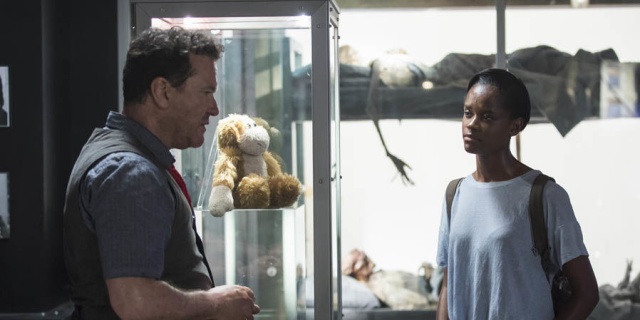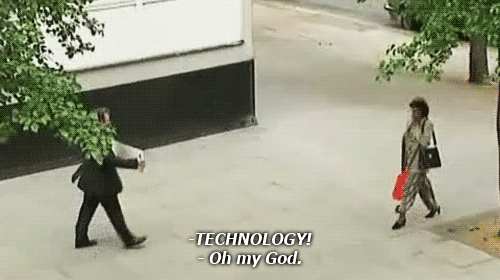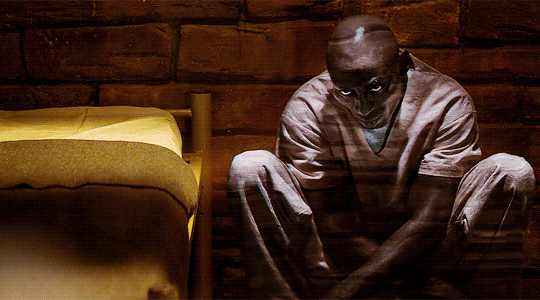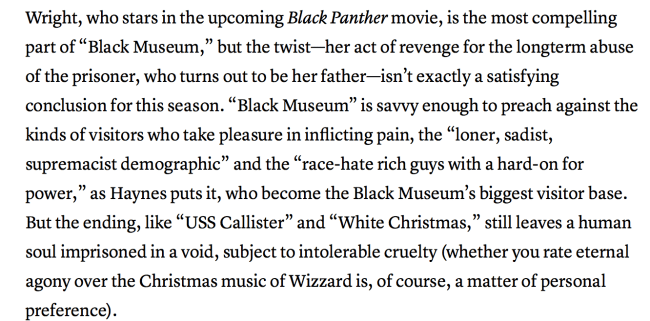“Black Museum” Episode of Black Mirror Shows Why We Need More POC Reviewing Shows

Dear white writers,
I know you’ve been assigned to review Black Mirror (because black people don’t get these assignments) so here’s how you can bring in 2018: email your editor and let them know that a black person should handle Black museum. You can do it.
— David Dennis Jr. (@DavidDTSS) December 31, 2017
SPOILER TALK FOR 4TH SEASON OF BLACK MIRROR

This season of Black Mirror was pretty good. I felt like the episodes that stuck with me were “USS Callister”, “Arkangel,” and “Hang the DJ”. “Metalhead” was okay, but the final twist sort of made me roll my eyes, I mean like…all of that for a teddy bear? “Crocodile” was hot garbage that I think was beautifully shot while being painfully dull. However, “Black Museum” left me with a much more mixed sense of emotions.
In “USS Callister” I feel we have had several female (and male) reviewers acknowledge the sexism at play with the characters. We understand that Robert Daley is a sexist asshole, who feels a deep sense of entitlement due to his brilliance and due to not being able to get the respect he believes he deserves, he decides to create DNA copies of his co-workers and put them into a game where he is God and they have to succumb to his every whim or face torturous punishment. It is a brilliant takedown of toxic masculinity that has a female coder save the day and is also a great homage to Star Trek. There is no review that doesn’t understand the gender dynamics at play or neglects to examine it fully.
However, from the reviews I’ve seen, it doesn’t seem like that same concern and care is being done with discussing the issues of race on the show. Black Mirror does not always create storylines where race is at the forefront, but that doesn’t mean it goes away or is invaluable to the larger conversation about an episode. Especially in “Crocodile” in which a white woman murders an entire brown family (possibly Muslim?) and in “Black Museum” which may have Easter Eggs, but the final story is very much about institutionalized racism and the treatment of black lives in the police system and society on the whole.
Yet that’s not being discussed because black and brown people are not getting to review the series if they are competing with white co-workers, as the tweet above discusses and the thread breaks down. I don’t think that their opinions on the episode would change if they felt the episode was fundamentally good or bad, but it would allow those voices to be heard and add to the discussion.
With “Black Museum” I see a lot of people calling it a dud of an episode because the vignettes don’t all hit the mark. Now, I will say that the first two stories are very wacky hard science fiction style tales that may lean into parody, but that doesn’t make them bad. The frame narrative is that a young black British woman named Nish is on holiday to visit her father. To kill time while her car is charging, she goes to the Black Museum where Rolo Haynes, the owner of the museum, tell hers the story of two devices there before showing her the main attraction. Rolo’s backstory is that he used to work in med tech, which is how he came across and knows the dark stories behind them.
The first story is about Dr. Peter Dawson at Saint Juniper’s (shout out) who gets an implant that will allow him to feel the pain/pleasure of his patients without feeling any negative physical side-effects. He gets to experience the male and female orgasm at the same time. Lucky him. That is until he gets a patient that dies while the transfer is happening. He feels all the effects of death without dying. It breaks him and Dawson soon becomes addicted to the feelings of pain, fear, and death. This is all done with the snarky narration going over it that makes the story more dark comedy than just grim-dark. To me, it works, especially since the main goal is not simply to tell these stories, but show that people take pleasure of hearing about the stories.
The second story is about Jack and Carrie, a couple that hooks up, has a kid, and falls in love. Then Carrie gets hit by a truck. She is stuck in a coma while Jack raises their child alone. Then Rolo shows up offering Jack a piece of technology that will allow him to share his brain capacity with Carrie. She will see what he sees, taste what he tastes, and feel what he feels. They can hear each other, but Jack has control of the body. It goes as well as you think. First Jack finds a way to put Carrie on pause and then, once he is in a new relationship, the stress makes him and his new girlfriend go to Rolo to see if they can fix the problem. There are two options: deletion, which would kill her since she no longer has a body to return to, or they transfer her body into a teddy bear with limited communication. They choose the latter and the episode reveals that Carrie is still in that bear since the technology used to put her mind in there was deemed inhumane, but there is no one who wants her now.
The final story is about Clayton. In the first two stories, we hear news coverage of a weather girl who was murdered and learn that her murderer is found. Clayton’s story completes the triangle. He was falsely accused of the murder and put on death row. Rolo, now kicked out of the hospital for two really bad screw-ups, wants to take his med-tech to create holograms of dead celebrities. However, when he realizes that would be expensive, he decided ex-cons would be just as good. He convinces Clayton that if his pardon does not go through his digital copy will be the property of Rolo and the money from this museum will go to his family. Clayton’s pardon doesn’t go through and he is executed.
Rolo brings Clayton to his cell in the museum and boots him into his system. The hologram is not “real” but it is alive and it feels the pain of being electrocuted everytime it happens. See Rolo knows that just having him stand around isn’t an attraction but people getting to pull the lever over and over again on a convicted killer-tapping into their racism and prejudice that is a moneymaker.

But Rolo is leaving stuff out. He is leaving out that Clayton’s family loved him and protested what was being done to him and that the result made tourism dry up, leaving Rolo to cater to perverts and racists who would pay extra to keep the electricity on Clayton a little longer, which leads to him being in a vegetative state. Nish knows all of this because she is Clayton’s daughter and she is here to free her father. She uses the technology from story two and some poisoned water she gave Rolo earlier to incapacitate him. She transfers his consciousness into her father and pulls the leaver to finally give the copy enough juice to die and takes Rolo along for the painful ride.
Nish then walks out of the Black Museum, teddy bear in hand, but not before burning the whole thing down. Before the episode ends we see that Nish’s mother was inside of her head watching the whole thing. They drive off together having gotten some justice for their loved one.
Now, you can argue about a lot of things with this episode. It has weird pacing, especially the first vignette. However, I saw one review online that made me really irritated.

(Review from The Atlantic by Sophie Gilbert)
Isn’t a satisfying conclusion? I find that type of analysis to be very ignorant consider that this review was posted December 31st 2017, the day after the death of Erica Garner. Erica Garner was the daughter of Eric Garner, who was killed at the hands of police officers who suffocated him in an illegal headlock that left him unable to breathe. Ms. Garner was placed in a medically induced coma the week before after an asthma episode precipitated a major heart attack, according to The New York Times.
Erica Garner died seeing no justice done for her father and her mother has to now bury her child, who gave the last years of her life fighting a battle that has no end in sight. Therefore to have this piece of science fiction give at least some sort of victory in that regard is a big deal. It is a catharsis.
Not to mention just like the “USS” episode references a lot of the ways sexism happens in the workplace, “Black Museum” is also talking about the way that black pain has been a part of “entertainment”. Let’s not forget people went to lynchings and burnings and took souvenirs and made postcards of those events. Not to mention medical doctors who would use slaves as patients because they were not seen as people and did not need to be treated humanely. The commentary about how society is willing to condone the inhuman treatment of black criminals, because they have been decided to be guilty, even on weak to no evidence. Let’s not forget, as well, Clayton is accused of killing a white woman. None of this is accidental and yet, none of this is mentioned in any of the reviews I’ve seen. Maybe a word or two about the racism, but nothing digging deeper to show why this episode reflects a narrative about the black catharsis that we might need in 2018.
Which is why we need to have more POC/WOC doing reviews for shows like these. “Black Museum” is still a messy episode, but the story it is telling and the value of that story in the highly racially polarized world we are living in makes it more than a “dud.”

(image: Netflix)
Want more stories like this? Become a subscriber and support the site!
—The Mary Sue has a strict comment policy that forbids, but is not limited to, personal insults toward anyone, hate speech, and trolling.—
Have a tip we should know? [email protected]
